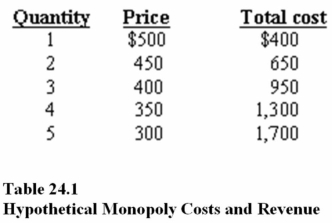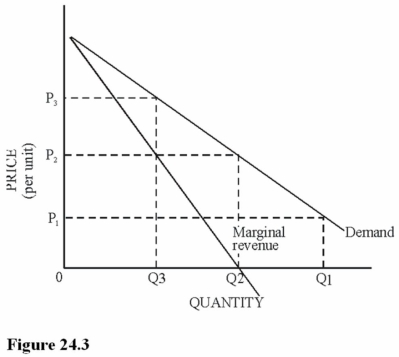A) Acquisitions.
B) Lawsuits.
C) Antitrust laws.
D) Discounts for customer loyalty.
Correct Answer

verified
Correct Answer
verified
Multiple Choice
Google is currently being investigated by
A) The European Antitrust Authority.
B) The U.S. Justice Department.
C) Intel corporation.
D) The FTC.
Correct Answer

verified
Correct Answer
verified
True/False
A monopolist with the ability to use price discrimination produces more to maximize profit than it would if it could charge only one price.
Correct Answer

verified
Correct Answer
verified
Multiple Choice
Suppose a monopoly concrete contractor builds 20 driveways per month for $10,000 each. In order to increase sales to 21 driveways, the contractor must lower the price of driveways to $9,500. The marginal revenue of the 21st driveway is
A) $500.
B) $199,500.
C) -$500.
D) $9,500.
Correct Answer

verified
Correct Answer
verified
Multiple Choice
Market power is
A) A characteristic of all market structures.
B) The ability to alter the market price of a product.
C) Most common for competitive firms.
D) Enjoyed by all firms at high levels of output.
Correct Answer

verified
Correct Answer
verified
True/False
Antitrust laws can restrain the abuse of monopoly power.
Correct Answer

verified
Correct Answer
verified
Multiple Choice
Google holds market power by all of the following strategies except
A) Purchasing rivals.
B) Low pricing.
C) Exclusive dealings with advertisers.
D) Elimination of search results for competitors.
Correct Answer

verified
Correct Answer
verified
Multiple Choice
 In Table 24.1, using the profit maximization rule, a monopolist that is able to practice price discrimination will charge
In Table 24.1, using the profit maximization rule, a monopolist that is able to practice price discrimination will charge
A) A price of $450.
B) A price of $400.
C) A price of $500.
D) Different prices to different customers.
Correct Answer

verified
D
Correct Answer
verified
Multiple Choice
The Microsoft Corporation was sued by the government for all but which one of the following antitrust violations?
A) Discouraging computer manufacturers from installing any operating system other than Microsoft's.
B) Buying out potential competitors.
C) Bundling software.
D) Stealing competitors' secrets.
Correct Answer

verified
D
Correct Answer
verified
Multiple Choice
A monopoly
A) Maximizes profits at the output level where P = MC.
B) Is one of many sellers in a given market.
C) Charges higher prices than competitive firms, ceteris paribus.
D) Maximizes profits at the output level where P = MR.
Correct Answer

verified
Correct Answer
verified
Multiple Choice
An In The News article titled "Ticketmaster Rolls Out Dynamic Pricing" indicates that Ticketmaster
A) No longer has a monopoly on online ticket ordering.
B) Was broken into two separate companies because of its monopoly position.
C) Will lower ticket prices on all events.
D) Will allow seats at certain events to be priced by supply and demand.
Correct Answer

verified
Correct Answer
verified
Multiple Choice
A monopoly can have a high degree of market power because of all but
A) Control over key inputs.
B) Government-bestowed franchise rights.
C) A downward-sloping demand curve for its product.
D) The presence of many close substitutes for its product.
Correct Answer

verified
Correct Answer
verified
Multiple Choice
If the entire output of a market is produced by a single seller, the firm
A) Is a monopoly.
B) Faces perfectly inelastic demand.
C) Can charge any price it wants and not lose customers.
D) Is producing a new product.
Correct Answer

verified
Correct Answer
verified
Multiple Choice
Which of the following is not an example of price discrimination by the only movie theater in town?
A) Charging a lower price for children under the age of 12.
B) Charging a lower price for matinees.
C) Charging a lower price for people over the age of 65.
D) Charging one price at all times for all customers.
Correct Answer

verified
Correct Answer
verified
Multiple Choice
Which of the following is the same for monopoly and competition under the same cost and demand conditions?
A) The amount of output that is produced.
B) Economic profits.
C) The goal of maximizing profits.
D) Efficiency of production at the profit-maximizing output.
Correct Answer

verified
Correct Answer
verified
Multiple Choice
Price discrimination is best defined as
A) Charging an excessive price for a product.
B) The charging of different prices by different companies for the same product.
C) The selling of an identical good at different prices to different consumers by a single seller.
D) The selling of differentiated goods to consumers at different prices.
Correct Answer

verified
Correct Answer
verified
True/False
In the long run, a monopolist can continue to earn economic profits.
Correct Answer

verified
True
Correct Answer
verified
True/False
Lawsuits can act as a barrier to entry in monopoly markets.
Correct Answer

verified
Correct Answer
verified
Multiple Choice
The marginal revenue of a monopolist falls below price because the firm
A) Is not limited by market demand.
B) Faces a market demand curve that is inelastic.
C) Confronts a downward-sloping demand curve.
D) Has an upward-sloping marginal cost curve.
Correct Answer

verified
Correct Answer
verified
Multiple Choice
 Refer to Figure 24.3. Which of the following statements is true about the price elasticity of demand at price P2?
Refer to Figure 24.3. Which of the following statements is true about the price elasticity of demand at price P2?
A) The price elasticity is elastic.
B) The price elasticity is unitary.
C) The price elasticity is inelastic.
D) The price elasticity is zero.
Correct Answer

verified
Correct Answer
verified
Showing 1 - 20 of 151
Related Exams